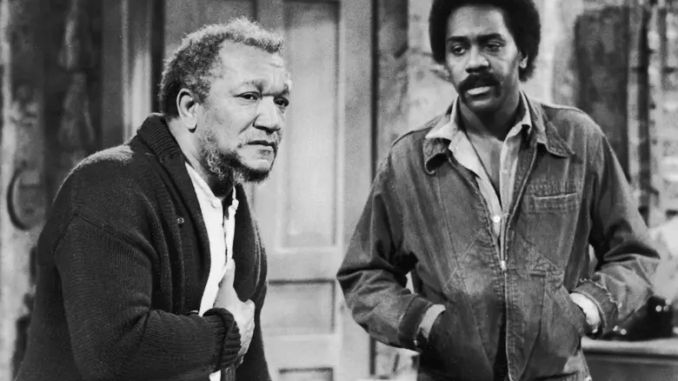
The landscape of 1970s television was irrevocably shaped by the explosion of honest, groundbreaking Black sitcoms, and at the heart of this revolution was Norman Lear’s smash hit, Sanford and Son. While the show’s volatile energy was powered by the legendary insults exchanged between Redd Foxx’s Fred Sanford and LaWanda Page’s Aunt Esther, the true warmth and stability of the series often rested on the shoulders of its supporting cast.
Few actors embodied this grounding force better than Raymond Allen, who masterfully played the recurring role of Uncle Woodrow “Woody” Anderson. As Aunt Esther’s long-suffering, yet loving, husband, Allen brought a unique blend of quiet humor and gentle decency that anchored the show’s most chaotic scenes. His enduring legacy across Sanford and Son and other prominent ’70s sitcoms highlights his critical, yet often unsung, contribution to television history.
The Essential Triangle: Woody, Esther, and Fred
Raymond Allen’s role as Woody Anderson was a deceptively simple one, yet absolutely vital to the comedic and emotional structure of Sanford and Son. Woody was frequently caught in the crossfire of the show’s most famous feud: the venomous rivalry between his wife, Aunt Esther, and his brother-in-law, Fred Sanford.
While Esther’s character was built on fire and brimstone, often charging into the junkyard ready to fight Fred, Woody was the calm eye of that hurricane. He was kind, soft-spoken, and often timid, serving as a hilarious juxtaposition to his aggressive wife.
The Comedic Gold
Woody’s interactions generated comedic gold in several ways:
- The Human Shield: Woody was often used by Fred as a punchline or a pawn, and by Esther as an unwilling accomplice in her schemes. His simple “uh-huh” or his wide-eyed look of exasperation as his wife launched into another verbal attack against Fred became a reliable comedic beat.
- The Foil to Esther: Without Woody, Aunt Esther’s character risks becoming purely abrasive. His unwavering, though often tested, love for her provided a layer of humanity and relatability. It showed that underneath her ferocious demeanor, Aunt Esther was a woman who was loved and capable of loving, making their marriage a surprisingly sweet core amidst the shouting.
- A Different Kind of Black Man on TV: Woody offered a quiet strength that contrasted with the more boisterous male characters like Fred and his friend Grady. He represented the working man who was devoted to his family, often trying to make peace rather than war. This subtle portrayal added to the sitcom’s rich tapestry of Black life.
Raymond Allen’s subtle physicality—the shrugs, the slow takes, the way he would gently try to pull Esther away before the fight escalated—spoke volumes, proving that a character didn’t need the loudest lines to be memorable.
Bridging the Sitcom Universe: Allen’s Versatility
Raymond Allen’s impact was not limited to the Sanford junkyard. His career in the 1970s made him a familiar and trusted face across the entire Norman Lear sitcom universe, a feat of versatility that few actors achieved.
Before, during, and after his time as Woody, Allen had a recurring role on the sister series Good Times as Ned the Wino. In stark contrast to the gentle and relatively put-together Woody, Ned was a derelict character who provided a grittier view of urban life.
His ability to convincingly pivot between these two highly recognizable roles—from the decent, church-going husband to the neighborhood alcoholic—demonstrated a tremendous range. It solidified his status as a consummate character actor, capable of breathing life and specificity into supporting roles across different shows with vastly different tones. He also made appearances on other classics of the era, including The Jeffersons and Starsky and Hutch, further cementing his presence in television history.
This consistency of talent across multiple high-profile series speaks to his professionalism and the trust that producers like Lear placed in his ability to deliver authentic performances, even in small doses.
The Enduring Cultural Echo
The legacy of Raymond Allen and his role as Woody Anderson continues to echo through television history, long after the show’s final episode aired in 1977.
- A Symbol of Stability: In a show that was intentionally written to be loud, messy, and confrontational, Woody provided a necessary emotional safe harbor. This stability is a key reason why Sanford and Son remains so rewatchable—the drama has real stakes because the characters have real relationships, and Woody’s marriage to Esther is the perfect illustration of that emotional grounding.
- The Blueprint for Supporting Roles: Allen’s performance is a case study in how to make a supporting character essential. He didn’t need a massive storyline or a huge monologue; he simply needed to react honestly to the chaos around him. His presence elevated LaWanda Page’s performance and softened the edges of Redd Foxx’s.
Raymond Allen, who was born on March 5, 1929, in Kansas City, Missouri, and passed away on August 10, 2020, at the age of 91, stepped away from the spotlight in the mid-1980s due to illness. However, the work he left behind, particularly his definitive portrayal of Woody, remains a vital part of the golden age of the Black sitcom.
His passing marked the loss of another link to a pivotal era in television—a time when comedy was used to push boundaries and explore complex social issues through laughter. Woody Anderson wasn’t just a character; he was the quiet, loving counterpart to one of the most famously abrasive characters in TV history, and in doing so, he became a beloved figure whose simple grace continues to define the heart of Sanford and Son.
